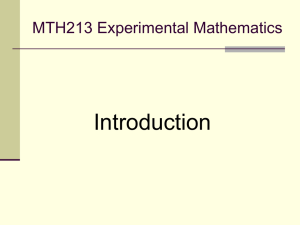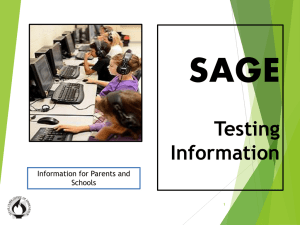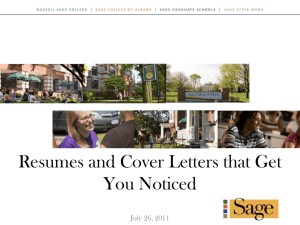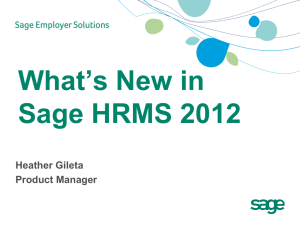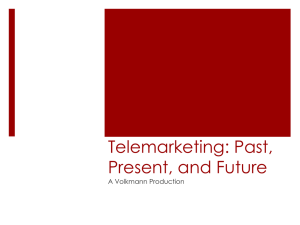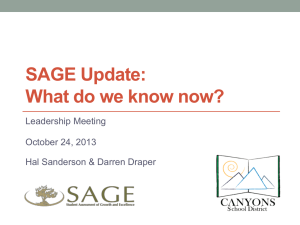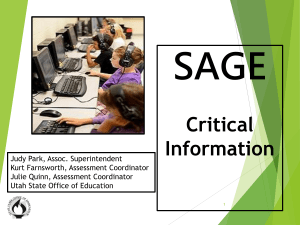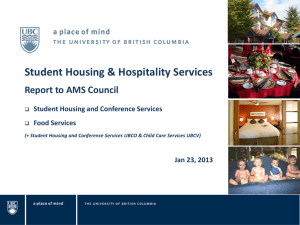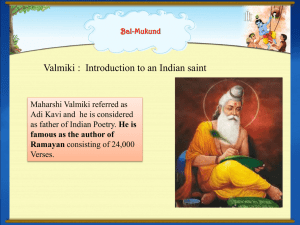Seismic Reflection and Refraction
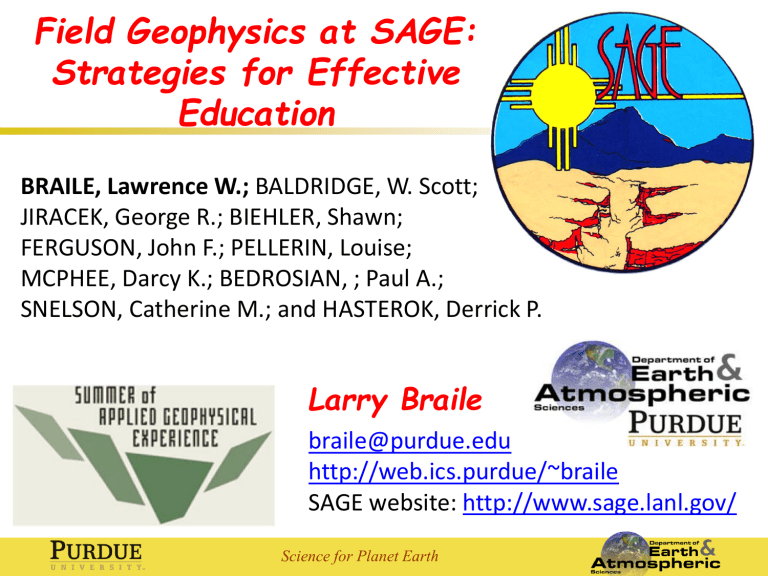
Field Geophysics at SAGE:
Strategies for Effective
Education
BRAILE, Lawrence W.; BALDRIDGE, W. Scott;
JIRACEK, George R.; BIEHLER, Shawn;
FERGUSON, John F.; PELLERIN, Louise;
MCPHEE, Darcy K.; BEDROSIAN, ; Paul A.;
SNELSON, Catherine M.; and HASTEROK, Derrick P.
Larry Braile
braile@purdue.edu
http://web.ics.purdue/~braile
SAGE website: http://www.sage.lanl.gov/
Science for Planet Earth
A Brief History of SAGE
(Summer of Applied Geophysical Experience)
2012 – Our 30 th Year!
SAGE is a unique program of education and research in geophysical field methods for undergraduate and graduate students from any university and for selected professionals. The core program is held for four weeks each summer in New Mexico and for an additional week in the following academic year at San Diego
State University for U.S. undergraduates supported by NSF. Each year 25-30 students participate in SAGE after being selected from a wide range of large and small colleges and universities.
Since SAGE was initiated in 1983, 730 students have participated in the program. NSF Research Experience for Undergraduates (REU) funding for SAGE began in 1990 and 319 REU students have completed SAGE through 2011.
Main Objectives of SAGE
Teach the Major Geophysical Exploration Methods
(Seismic, Gravity, Magnetics, Electromagnetics)
Apply the Methods to the Solution of Specific Problems
(Environmental, Archaeological, Hydrologic, Geologic
Structure and Stratigraphy)
Integration of Methods, and Geology
Present Career Options in Geophysics
Student Professional Development
Research in the Rio Grande Rift Area
SAGE Program Schedule Summary
Summer (~4 weeks, Rio Grande rift area, New Mexico)
Exploration geophysics theory and applications, classroom/lab/discussion (7 days).
Geophysical field work (1 day – near-surface archaeological site, 5 days – basin scale field area).
Geology field trips (3 days).
Data processing, analysis, interpretation, preparation of oral and written reports – interpretation and method teams (5 days).
Student presentations and written reports (2 days).
Presentations by visitors – industry, government, academia (mostly evening talks, equivalent of 2 days).
R & R days (2 days).
Follow-up workshop for REU students in January
Additional analysis and interpretation of the data from summer and preparation of abstracts for presentation at professional meetings (5 days).
Geophysical Exploration Methods
Near-surface Archaeological geophysics – seismic refraction, electromagnetics (EM), magnetics, GPR
Basin scale field area –
Gravity/GPS
Seismic refraction
CMP seismic reflection profiling
Magnetics
Magnetotellurics (MT)
Transient Electromagnetics (TEM) Seismics
Magnetics GPR EM
Gravity/GPS
Gravity Stations and Map
Magnetics
Archaeological Site - GPR
Kiva?
GPR Image
1 m
Seismic Reflection and Refraction
“Flagging”
Vibroseis Truck
Driving the Vibe Truck – “Priceless”
SAGE Student Driver – Whoa!!!
Seismic Reflection and Refraction
Fault
Refraction
Reflection shot gathers
Seismic Reflection and Refraction
Processed and Stacked CMP Reflection Section
Seismic data acquisition in the
“doghouse”
Electromagnetics
1800 m
N
Electromagnetics
2-D Model of TEM Soundings
1700 m
1600 m
1500 m
0 m Distance
S
Blue is resistive
200
0
Red is conductive
3400 m
SAGE 2010 Geophysics Highlights
Blue is resistive
MT sounding indicating midcrustal conductor at
~ 20 km depth.
West-East CMP stacked seismic reflection record section. La Bajada fault plane reflections on right.
Successful Strategies
(developed and refined over the years)
1. Learning by doing; immersion ( intense program/schedule ).
2. Mix of lecture/discussion; field work; data processing and analysis; modeling and interpretation; presentation of results.
3. Two tier team approach ( interpretation/integration teams – each team includes person representing different methods; technique oriented teams ). Provides focus, indepth study, opportunity for innovation ( technique oriented teams ), and promotes teamwork and multidisciplinary approach ( interpretation/integration teams ).
4. Emphasis on presentations ( discussion on how to prepare and deliver a 12 minute talk ) – teams (all team members) make presentation; each student completes a written report (SEG expanded abstract format); professional development.
Successful Strategies
(developed and refined over the years)
5. Experiment Design Discussion – safety, constraints, data quality/quantity, research objective, educational experience, set parameters for survey, why multidisciplinary?, etc. Students drive discussion.
6. Multiple methods (each student gains experience with all methods), and information on careers (students really appreciate); networking .
7. Student experiences and interactions (many of the students become friends for life).
8. Measures of success - High rate of continuation to graduate school (about 75% of SAGE undergraduates), support and feedback from industry participants and visitors , student evaluations at end of program, presentations at professional meetings, publications, faculty evaluation of student work.
SAGE Students – Geology Field Trip
SAGE website: http://www.sage.lanl.gov/
Additional SAGE Information:
8:00 AM – 12:20 PM, Tuesday, Dec. 6, MCS Halls A-C
T21A-2316. Seismic and Gravity Investigation of the
Eastern Boundary of the Santo Domingo Basin, Rio Grande
Rift, New Mexico (Poster)
8:00 AM – 12:20 PM, Tuesday, Dec. 6, MCS Halls A-C
H21E-1170. Geophysical Characterization by the SAGE
Program of a Newly Proposed, Low Temperature-EGS
Prospect in the Central Rio Grande Rift, New Mexico (Poster)
SAGE 2012 Information: http://web.ics.purdue.edu/~braile/sage/SAGE2012.pdf
SAGE website: http://www.sage.lanl.gov/
This PPT: http://web.ics.purdue.edu/~braile/sage/FieldGeophysics.ppt
Challenges for the Future
Maintaining funding
Program is expensive (low student/faculty ratio, all offcampus, geophysical equipment and field work).
Support for SAGE (funds and “in-kind” support): NSF
REU program, Los Alamos Natl. Lab, US DOE, USGS,
Industry, Society of Exploration Geophysicists, participating universities.
Recruitment
We continue to have many excellent student applicants
However, we have had limited success in increasing the diversity of SAGE students.
Added a component of SAGE to involve Native American students from New Mexico Pueblos.
Maintaining momentum and continuously enhancing program
Requires significant commitment of faculty.
Enhancements each year based on student feedback and faculty consideration of successes and failures.


